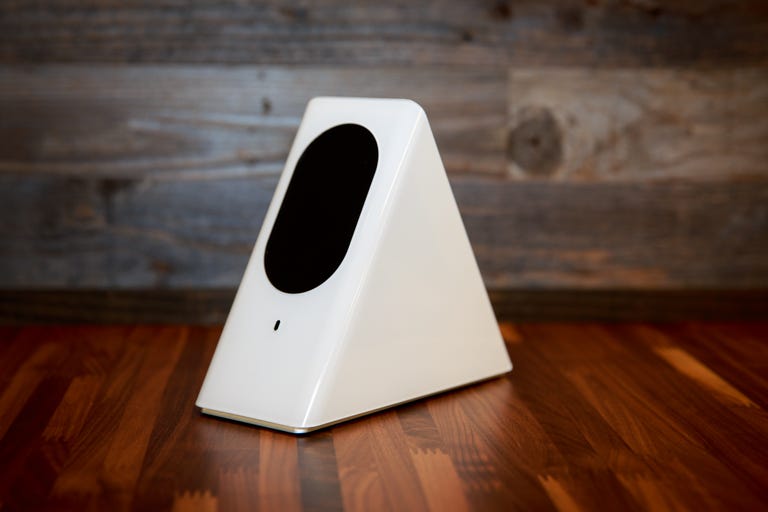 Why You Can Trust CNET
Why You Can Trust CNET Starry Wi-Fi Station review: Home networking simplified -- for a price
The Starry Wi-Fi Station is the latest "router for dummies." It's easy to use and works well -- but is it worth that hefty price?
Starry caused a big splash back in February when it promised a revolutionary new wireless Internet service. That service isn't here yet -- it's scheduled to launch later this summer in Boston. In the meantime, the company's Starry Wi-Fi Station router, which works just fine with any plain old broadband service, has arrived.
The Good
The Bad
The Bottom Line
This router is the newest in the procession of "routers for dummies" -- products such as the Eero and Google OnHub, made for those intimidated by the home network setup process. For advanced users like me -- those who like having browser-based controls and meticulous network setup options -- find products like these to be oversimplified and generally lacking.
But if you're confused by networking terminology such as WAN, LAN, SSID, DNS, 802.11ac and MIMO, these products are well worth checking out. And from that perspective, the Starry Wi-Fi Station is a success. If you want a solid router that is as easy to use as programming your alarm clock, you'll love it. But that simplicity comes at a steep price: The Starry Wi-Fi Station costs $350. (It's not available in the UK or Australia, but its US price translates to about £245 or AU$475.)
The Starry Wi-Fi Station comes with a speaker and a mic for future voice-command features.
What does the Starry Wi-Fi Station do?
As a Wi-Fi router, it connects to an Internet source (such as a broadband modem) and then shares that connection with multiple wireless devices, such as your laptop, your iPad and your mobile phone. All Wi-Fi routers do this.
The Starry supports the dual-band quad-stream (4x4) setup of the 802.11ac Wi-Fi standard, meaning it has a top Wi-Fi speed on paper of 1,733Mbps, which is the fastest to date. It supports all existing Wi-Fi devices on the market.
What makes the Starry different from traditional Wi-Fi routers?
- The router has a unique design, shaped like a 7-inch equilateral triangle standing on one of its sides, with the base measuring 3 inches wide. It sure looks unlike any router I've seen, though some of my colleagues thought the router actually looked ugly.
- On the front it has a 3.8-inch touchscreen used for both the initial setup process and ongoing management of the router. (Most other routers don't have a screen at all, but this feature has been seen before on products such as the Securifi Almond.) This screen also displays what Starry calls the "network health score," Wi-Fi network name and password, currently connected devices and some other information. You can tap or swipe on the screen to switch between different info pages or run an Internet speed test.
- On the back, the router has only two network ports, as opposed to five on most others: one for the Internet connection (WAN) and the other for one wired client (LAN), such as a desktop computer or Roku box. This means if you want to connect more than one wired client, you will need to get a switch or a hub in order to add more ports.
- The router has a mic and a small speaker. Neither of these is currently used for anything. In the future, however, according to Starry, the ability to support voice commands will be added via a software update.
- With a focus on simplicity, the Starry is designed to be managed via a free mobile app on Android or iOS devices. Advanced users may lament the lack of a browser-based setup interface, though Starry says the company might add that sort of expert mode in the future.
- Starry says the router is "Internet of Things"-ready, with built-in support for home automation wireless standards, such as ZigBee. Again, this feature is not live at launch and will be released as software updates in the future.
Is it really that easy to set up?
Yes. The setup process is dead simple. You just plug the Starry into the power, connect its WAN port to a broadband modem, and turn it on. After that, via the touchscreen, you can pick a name and password for your Wi-Fi network from randomly generated options or type them in yourself. And that's it.
Can you easily customize its settings?
Not really. Once the setup process is done, other than turning the Guest network and the 5GHz band on or off, you can't use the touchscreen to customize anything else, even the network name and the password. All you can do is view information and reset the router to its original factory settings, then restart the setup process from the beginning.
If you want to customize its settings at all, you will need to use the Starry mobile app. To use this app, however, you will first need to register an account with Starry, which allows you to manage your home network even when you're out and about. In return, from then on the router will be connected to Starry at all times. And even then, its potential for customization is limited. You can't choose a name for the 5GHz band, for example: The router automatically takes the name of the 2.4GHz band plus the "_5" suffix. Similarly, the guest network would have the suffix "_Guest."
What information is collected by Starry via the Wi-Fi Station?
According to Starry, it collects throughput usage, "network health" score, speed tests, connected device types and router configuration. It then stores the configuration state of the router and telemetry data (speed test, throughput, ping and so on) so that it can display the graphs to the user via the touchscreen or the mobile app. It also collects data around how users use the device, such as which screen on the mobile app they spend the most time using, and so on.
Starry says it doesn't collect information on what users are doing online, such as the websites they visit, what apps they use, what movies or audio they stream and so forth.
What exactly is the Health Score?
Good question. The router's screen shows a "Health Score" for your network in a range from 0 to 100 percent. Starry says that "anything over 60 percent means you're in good shape," which raises the question: why is there a 0-to-100-percent range in the first place? It's impossible to discern the difference between a few percentage points, such as between 60 and 63 percent, or even between 80 and 90 percent. And in my trial, this number fluctuated regularly in the 90s even when there weren't any changes made to the network. It'd be more helpful if instead it showed the network health as bad, good or excellent.
Does the router have a lot of features?
No. Other than the Health Score -- which I thinks is largely a gimmick -- the router, at least at its current stage, has nothing else of note compared with other routers. In fact, the only feature it has is the simple parental control called "Screen Time," which dictates when a connected computer can access the Internet.
This might change, however, when the router gains a Web user interface and its hardware is fully activated.
Starry says the Wi-Fi Station can be placed anywhere in your home. Is that true?
Not really. Starry says that the Wi-Fi Station "was designed to live anywhere in your home" -- suggesting that it'd fit in anywhere thanks to its good looks -- and that "placing Starry Station in the right spot gives you strong Wi-Fi where you need it most." The truth is that, just like any router, the Starry needs to be placed near the Internet source (your broadband modem) unless you're willing to run a long network cable to connect the two.
- Close range
- Long range
How about performance?
Excellent. The Starry Wi-Fi Station worked well in my testing. It has a sustained speed on the 5GHz band of 711Mbps at a close range of 10 feet, which is among the best I've seen. When I increased the distance to 75 feet (with one wall in between) it then registered 327Mbps -- still impressive. On the crowded 2.4GHz band, the router didn't do as well, averaging 121Mbps and 24Mbps for close and long ranges, respectively.
The router passed the stress test with flying colors, being able to constantly handle heavy tasks between multiple devices for two days without disconnecting even once. Its range wasn't the best I've seen, however, with the effective range topping out at around 100 feet. Farther than that, it's hard to hold a steady connection to the router. Note that range depends a lot on the environment, and I tested it in a very crowded airspace, so your mileage might vary.
Should I get one?
If you just want a solid and super-easy-to-use router to share your Internet, the Starry is a great device, assuming you can stomach its price and you live in a relatively small home. Still, you might want to wait until those extra hardware features -- such as the Internet of Things compatibility -- are fully activated before getting one.
On the other hand, if you don't mind a bit of work on the initial setup, there are many other somewhat less-easy-to-use options but with better performance and more features, and some cost even less than half of the Starry's price. And if you still want a similarly user-friendly yet feature-limited router, the Google OnHub is also a much cheaper alternative.



